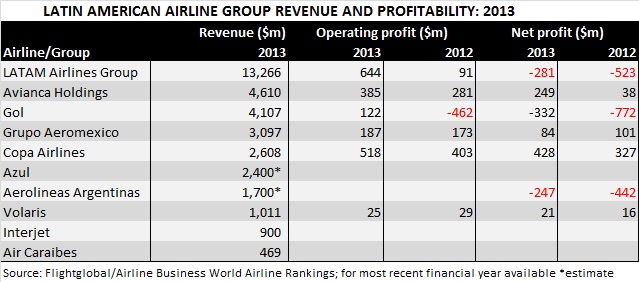For many Latin American carriers, 2013 was a year of steady progress after a difficult and transitional period following consolidation in the region and reduced levels of profitability for some.
This year’s Airline Business/Flightglobal World Airline Rankings shows collective operating profits among six of the region’s biggest carriers more than trebled to $1.87 billion. There were notably sharp improvements in the performance at LATAM and Gol, the region’s biggest and third largest carriers by revenue – though the latter’s net loss for the year show it remains a work in progress.

If Gol has slowed its growth of late, other low-cost carriers in the region have continued to grow strongly.
Much of the attention in the region is being taken by a wave of relatively young low-cost carriers beginning to spread their wings beyond their home countries, planning their first international flights after winning a substantial market share back home.
Brazil’s Azul, more notably, is planning to begin its first international flights to the USA as early as December. This comes after the five-year-old airline scaled its way to become the third dominant player in the domestic Brazilian market after TAM and Gol.
Based at Viracopos-Campinas airport, Azul is adding Airbus widebodies to its fleet of Embraer jets and ATR turboprops. The carrier has agreed to acquire six Airbus A330-200s and five Airbus A350-900s on leases, and took delivery of its first A330 from ILFC in June.
The airline has applied for authority to begin flights to Fort Lauderdale and Orlando, and plans to follow with New York services in 2015. Azul says the choice of Florida makes sense due to the large number of Brazilians who have moved to south Florida.
Elsewhere in Latin America, Medellin-based VivaColombia is readying to begin its first international flights with services from Medellin and Bogota to Panama City.
The carrier will also begin flights between Bogota and Lima in the fourth quarter.
Like Azul, VivaColombia is now the third biggest player in its domestic market after Avianca and LAN Colombia. Even as domestic passenger growth in other parts of Latin America has slowed, the domestic Colombian market has grown steadily.
Despite having launched only in May 2012, the airline says it is ready to introduce low-fare competition on major trunk routes in the region that have long been dominated by legacy carriers. In line with its new international services, VivaColombia is opening a second base in Bogota and will base two Airbus A320s there.
Azul and VivaColombia’s international ambitions mirror the earlier efforts at other Latin American low-cost carriers such as Mexico’s Volaris and Interjet, which have expanded their networks outside of their home base. Volaris has been steadily growing in the USA, and operates flights to 14 airports in the country. Interjet, while flying to only five cities in the USA, has services to Bogota, Guatemala City, Havana and San Jose (Costa Rica).
Following a challenging first quarter in which domestic yields suffered, Volaris has said it is banking on strong capacity growth on its international routes as it has observed a better fare environment there. The airline will increase international capacity by more than 25% in the second quarter, it said in May.
Source: Airline Business























